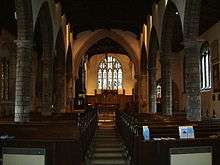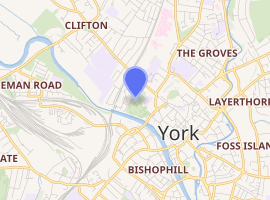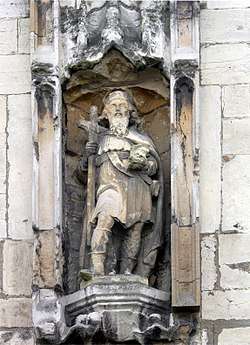St Olave's Church, York
St Olave's Church, York (pronounced Olive) is a Grade I listed[1] parish church of the Church of England in York.[2] It is situated on Marygate by St Mary's Abbey.
| St Olave's Church, York | |
|---|---|
 The interior of St Olave's church, facing east | |

| |
| Location | York |
| Country | England |
| Denomination | Church of England |
| Churchmanship | Liberal Catholic |
| Website | stolaveschurch.org.uk |
| History | |
| Dedication | St Olaf |
| Consecrated | c. 1050 |
| Architecture | |
| Heritage designation | Grade I listed[1] |
| Administration | |
| Parish | St Olave with St Giles, York |
| Deanery | York |
| Archdeaconry | York |
| Diocese | Diocese of York |
| Province | Province of York |
| Clergy | |
| Priest in charge | The Reverend Jane Nattrass |
.jpg)

History
St Olave's Church is situated within St Mary's Abbey walls, which was ruined in the Dissolution of the Monasteries. It is dedicated to St Olaf, patron saint of Norway. The Anglo-Saxon Chronicle entry for 1055 records that ‘This year died Earl Siward at York; and his body lies in the minster at Galmanho, which he had himself ordered to be built and consecrated, in the name of God and St. Olave, to the honour of God and to all his saints.’[3][4]
Galmanho is a former name for the area where the church stands and Siward, Earl of Northumbria, is believed to have had his York residence. This is the earliest date for a church dedication to St Olaf (Olav in Norwegian) anywhere.[5][6]
St Olave's Church was extensively rebuilt in the 15th century. Substantial repairs were carried out in the 1720s including the insertion of windows in the north aisle, the wall of which had earlier served as part of the abbey and later city defences. The church was restored in 1848 - 1849, and reopened on Wednesday 14 February 1849.[7][8]
The church was again renovated starting in 1887. After a closure of 5 weeks, the church reopened on 2 September 1888. The ceiling of lath and plaster which covered the central aisle of the nave was removed. The pillars, arches and north and west walls were stripped of paint and plaster.[9] A new chancel was added in 1887-9 by George Fowler Jones, a York architect, and later extended in 1906. This contains the five-light 15th-century east window. Despite these changes the architectural style is broadly 15th century.[10]
Current parish life
St Olave's has a strong musical tradition, with a large choir and recently restored organ, as well as a ring of six bells hung for change ringing. In addition the orchestra of the Academy of St Olave's performs three concerts each year and plays for one orchestral Mass on Remembrance Sunday. The Sunday sung eucharist is at 10.30 using Common Worship (order one, contemporary language).
Incumbents
Initially referred to as Chaplains, the post was Curate from 1499, and Vicar from 1663.
- 1389 Thomas
- 1390 John Kilburn
- 1300 William de Malton
- 1432 Thomas Proktoure
- 1433 Thomas Wright
- 1437 Robert
- 1438 William Kirkeby
- 1445 William Hardy
- 1445 John Litster
- 1458 Thomas Dobson
- 1463 Thomas Eston
- 1471 John Rudby
- 1489 Gilbert Baxter
- 1496 Robert Lelegrave
- 1499 William Philipson
- 1522 John Sissotson
- 1530 Richard Wilkinson
- 1550 Wilfrid Archer
- 1571 Robert Sayer
- 1573 Thomas Bowes
- 1608 Michael Vascoe
- 1610 Henry Brinckwell
- 1619 Henry Moore
- 1620 John Philliskirk
- 1634 John Belwood
- 1663 Thomas Tonge
- 1673 Walter Blakestone
- 1679 John Wild
- 1695 Thomas Moseley
- 1733 William Dodsworth
- 1754 William Ellis
- 1771 William Dade
- 1790 Ralph Worsley
- 1848 William Strong
- 1855 Frederick Bartlett
- 1877 William Hey
- 1883 William Croser Hey
- 1892 William Dodsworth
- 1905 Charles Bell
- 1915 Alfred Glover
- 1928 Walter Hollis
- 1932 Francis Windley
- 1946 Eric Denyer
- 1962 William Griffith
- 1970 Clifford Barker
- 1976 James Alan Heslop
- 1988 Anthony Hodge
Memorials
- George Hutchinson (d. 1775)
- Michael Loftus (d. 1762)
- William Etty (d. 1849)
Burials
Organ
The pipe organ was built by J. W. Walker & Sons Ltd and dates from 1907. A specification of the organ can be found on the National Pipe Organ Register.[11]
References
- Historic England. "Church of St Olave (Grade I) (1257387)". National Heritage List for England. Retrieved 6 May 2015.
- Pevsner, Nikolaus; Neave, David (1995). The Buildings of England. York and the East Riding. Yale University Press. ISBN 0300095937.
- The Anglo-Saxon Chronicle Part 5 : A.D. 1052 - 1069 The Online Medieval & Classical Library
- "Siward Earl of Northumbria". English Monarchs. Retrieved 1 May 2018.
- "St Olave's, Marygate". Secret York. Retrieved 1 May 2018.
- "Galmanho". Secret York. Retrieved 1 May 2018.
- "St Olave's Church, Marygate, York". English Churches - North Yorkshire. Retrieved 1 May 2018.
- "Restoration of St Olave's Church". Yorkshire Gazette. York. 17 February 1849. Retrieved 6 May 2015.
- "Re-opening of St Olave's Church". York Herald. York. 3 September 1888. Retrieved 6 May 2015.
- "Church of St Olave - North Yorkshire". History of York. Retrieved 1 May 2018.
- "NPOR E00971". National Pipe Organ Register. British Institute of Organ Studies. Retrieved 6 May 2015.
External links
| Wikimedia Commons has media related to St Olave's, Marygate. |